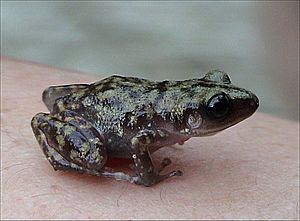Cliff chirping frog facts for kids
Quick facts for kids Cliff chirping frog |
|
|---|---|
 |
|
| Cliff chirping frog, Eleutherodactylus marnockii | |
| Conservation status | |
| Scientific classification | |
| Genus: |
Eleutherodactylus
|
| Species: |
marnockii
|
| Synonyms | |
|
Syrrhophus marnockii Cope, 1878 |
|
The cliff chirping frog (Eleutherodactylus marnockii) is a small frog. It lives in central and western Texas in the United States. You can also find it in northern Mexico, in a state called Coahuila. People sometimes call it the cliff frog or Marnock's frog.
Contents
What They Look Like
Adult cliff frogs are quite small. They are about 19 to 38 millimeters (0.75 to 1.5 inches) long. Their skin is often greenish with brown spots. They might also have stripes on their back legs.
These frogs have a somewhat flat body. This special shape helps them hide easily. They can squeeze into small cracks and spaces in rocks.
Where They Live and What They Do
Cliff chirping frogs are nocturnal. This means they are most active at night. They spend most of their lives on limestone rock faces. These are rocky cliffs and walls.
Like most frogs, they can hop around. But they are also good at crawling. This crawling skill helps them move into tight rock crevices. It keeps them safe from predators.
How They Reproduce
Cliff chirping frogs can lay eggs almost all year. They usually do not breed during the coldest parts of winter. The busiest time for breeding is during the rainy season. This is usually in April and May.
Female frogs can lay eggs up to three times a year. They lay their eggs in moist places. These spots are often in leaf litter or soft soil.
Images for kids
See also
 In Spanish: Eleutherodactylus marnockii para niños
In Spanish: Eleutherodactylus marnockii para niños



